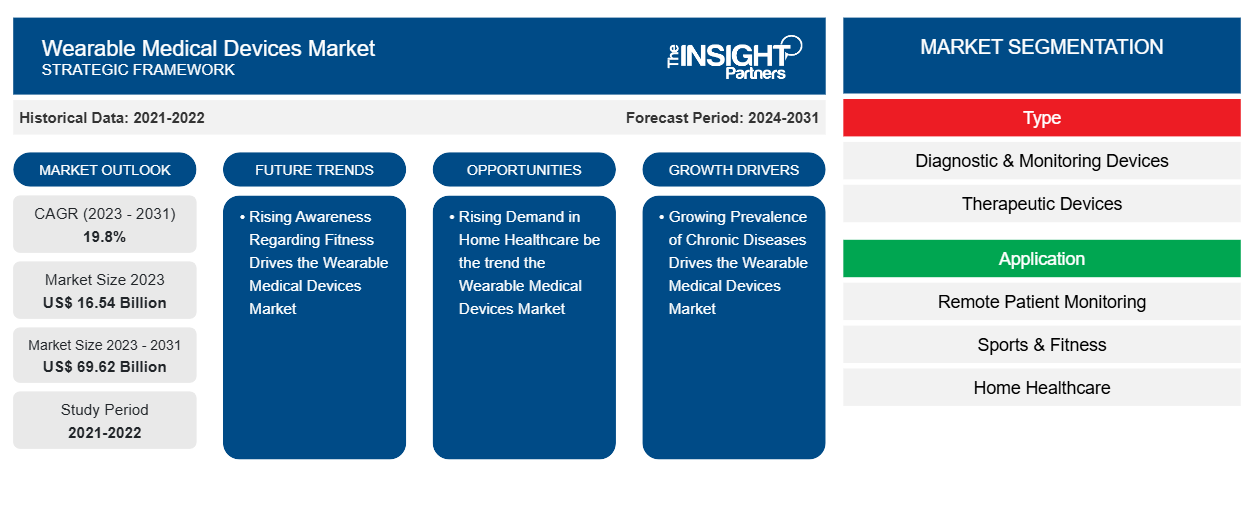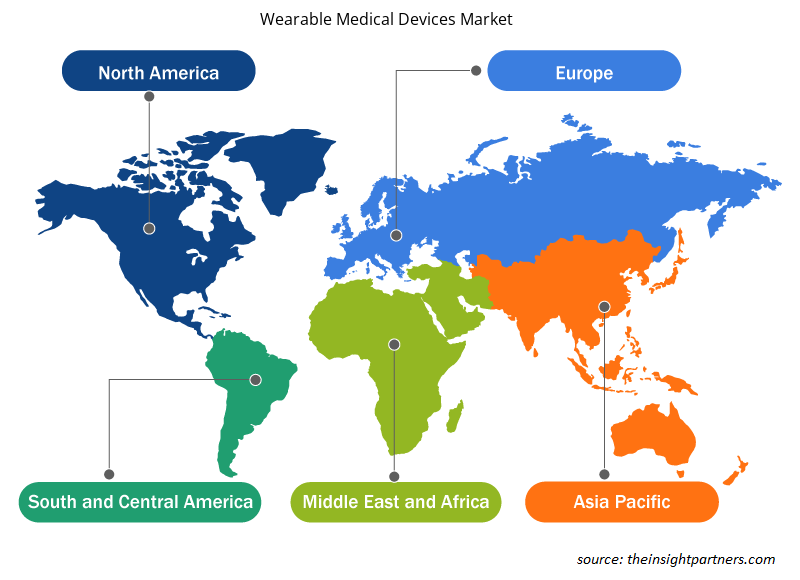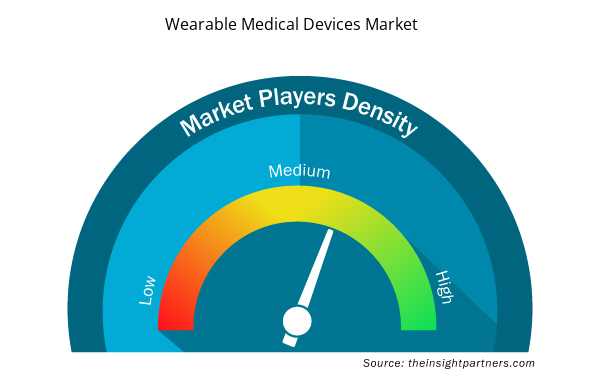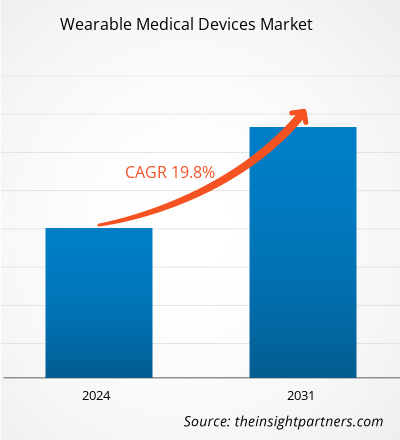The Wearable Medical Devices market size is projected to reach US$ 69.62 billion by 2031 from US$ 16.54 billion in 2023. The market is expected to register a CAGR of 19.8% during 2023–2031. The rise in the use of smart apparel is likely to remain a key trend in the market.
Wearable Medical Devices Market Analysis
The growing aging population and changes in social behavior and lifestyle contribute to some of the common long-term health conditions. As per the World Health Organization (WHO), the prevalence of chronic lifestyle diseases is expected to increase by 57% by the end of 2026. The emerging markets will be hit hardest, as a population explosion is expected in developing countries. With the increasing urbanization, people are more inclined toward a sedentary lifestyle, which results in rheumatoid arthritis, diabetes, and others. Diabetes is one of the major global health issues of the 21st century. According to the International Diabetes Federation (IDF), the number of people with diabetes in North America was about 46 million in 2019 and is projected to reach 62 million by 2045. The increase in disease prevalence is approximated to be 35% during the projection period.
Other chronic conditions such as Crohn’s disease, multiple sclerosis, and cardiovascular disorders require frequent drug administration for disease management and treatment. Wearable devices offer an opportunity to enhance the management of chronic diseases by improving connectivity between patients and physicians. Also, it increases patient engagement in managing their condition. In chronic diseases such as diabetes, each patient may have different lifestyle factors and physiological functions. Integrating data from wearable devices helps with personalized treatment approaches on a deeper level. Monitoring heart rate, blood sugar, respiratory rate, and other metrics can help physicians intervene sooner if signs of disease progression or acute issues are occurring, thereby driving the wearable medical devices market growth.
Wearable Medical Devices Market Overview
Factors such as the increasing prevalence of chronic diseases, the rising geriatric population, and rising awareness regarding the importance of fitness are key drivers for the growth of the market. However, factors such as unaddressed regulatory concerns and constant product recalls are likely to restrain the market growth to a certain extent during the forecast period. The Asia Pacific wearable medical devices market is anticipated to grow at the highest rate during the forecast period owing to the increase in the number of cases of chronic diseases and government initiatives taken for wearable medical devices. The prevalence of diabetes is an important factor responsible for the wearable medical devices market growth in China. According to the Public Library of Science (PLoS) report 2022, about 12% of the adult population in China had diabetes, which represents a 10-fold increase in the last 3–4 decades. The rising number of people with diabetes in China involves a complex interplay of socio-economic, demographic, environmental, and genetic factors. Additionally, major contributors include urbanization and the aging population, as well as decreasing physical activity, leading to a decrease in weight and obesity. Therefore, all the above factors are expected to drive the wearable medical devices market growth during the forecast period.
Customize This Report To Suit Your Requirement
You will get customization on any report - free of charge - including parts of this report, or country-level analysis, Excel Data pack, as well as avail great offers and discounts for start-ups & universities
Wearable Medical Devices Market: Strategic Insights

- Get Top Key Market Trends of this report.This FREE sample will include data analysis, ranging from market trends to estimates and forecasts.
Customize This Report To Suit Your Requirement
You will get customization on any report - free of charge - including parts of this report, or country-level analysis, Excel Data pack, as well as avail great offers and discounts for start-ups & universities
Wearable Medical Devices Market: Strategic Insights

- Get Top Key Market Trends of this report.This FREE sample will include data analysis, ranging from market trends to estimates and forecasts.
Wearable Medical Devices Market Drivers and Opportunities
Rising Awareness Regarding Fitness to Favor Market
With a growth in the number of chronic illnesses such as diabetes and hypertension, there has been a rise in awareness regarding one's fitness. Also, in recent days, there has been a significant rise in the number of individuals suffering from obesity. These factors have led to an increase in the importance of maintaining fitness. The demand for various health apps and devices for monitoring health status has increased significantly in recent years. Also, a considerable rise in the number of gyms and fitness centers across countries such as the US, India, and Canada has been recorded. The region of Asia Pacific is anticipated to offer significant growth opportunities in the fitness industry during the forecast period due to an increase in disposable income as well as the rate of urbanization in the leading economies such as Japan, China, and India. The use of fitness apps and digital devices for monitoring vital signs has been high among millennials as compared to individuals from other age groups. Owing to the growth in awareness regarding fitness and the benefits offered by wearable devices, the market for wearable devices is anticipated to witness significant growth during the forecast period.
Rising Demand in Home Healthcare
Wearable devices are available in compact sizes and are innovative in the way they function. In recent days, the use of wearable devices for home healthcare has increased significantly. The traditional method of treatment requires frequent visits to the physicians, and a lot of time is needed to obtain an appointment and wait for the tests and later for the results. Hence, wearable devices are being preferred widely by patients who wish to monitor their health by themselves. Sensors and devices automate many processes, speed up the diagnosis and treatment, and allow people to control their health. With the help of wireless data transmission, the health status obtained with the help of the device can be shared with the physician through which a suitable treatment can be suggested by the physician accordingly. Also, the rising costs associated with healthcare services and hospital stays and the shortage of healthcare facilities, physicians, nurses, and other skilled personnel, have led to an eventual demand for wearable for home healthcare. The rise in the preference for self-monitoring is anticipated to offer significant growth opportunities to the players operating in the wearable devices market to introduce innovative products in the market during the forecast period.
Wearable Medical Devices Market Report Segmentation Analysis
Key segments that contributed to the derivation of the wearable medical devices market analysis are device type and application.
- Based on device type, the wearable medical devices market is bifurcated into diagnostic & monitoring devices and therapeutic devices. Diagnostic & monitoring devices are further segmented as vital signs monitoring devices, glucose monitoring devices, sleep monitoring devices, and other devices. Therapeutic devices segment further subsegmented as pain management devices, rehabilitation devices, respiratory therapy devices, and insulin pumps. The diagnostic & monitoring devices segment held a larger market share in 2023.
- By application, the market is segmented into remote patient monitoring, sports & fitness, and home healthcare. The sports & fitness segment held the largest share of the market in 2023.
Wearable Medical Devices Market Share Analysis by Geography
The geographic scope of the wearable medical devices market report is mainly divided into five regions: North America, Asia Pacific, Europe, Middle East & Africa, and South & Central America.
North America has dominated the market. According to the International Diabetes Federation, in 2021, ~14 million adults in Mexico had diabetes, which has increased by 10% in the last two years. Furthermore, 11 million people have impaired glucose tolerance (IGT), which leads them to be at risk of developing type 2 diabetes. Various types of wearable medical devices can be beneficial for patients with diabetes. These devices can assist with insulin treatments, blood sugar measurement, and promoting a healthy lifestyle. Thus as the cases of diabetes are growing demand for wearable medical devices is increasing. Asia Pacific is anticipated to grow with the highest CAGR in the coming years.
Wearable Medical Devices Market Regional Insights
The regional trends and factors influencing the Wearable Medical Devices Market throughout the forecast period have been thoroughly explained by the analysts at Insight Partners. This section also discusses Wearable Medical Devices Market segments and geography across North America, Europe, Asia Pacific, Middle East and Africa, and South and Central America.

- Get the Regional Specific Data for Wearable Medical Devices Market
Wearable Medical Devices Market Report Scope
| Report Attribute | Details |
|---|---|
| Market size in 2023 | US$ 16.54 Billion |
| Market Size by 2031 | US$ 69.62 Billion |
| Global CAGR (2023 - 2031) | 19.8% |
| Historical Data | 2021-2022 |
| Forecast period | 2024-2031 |
| Segments Covered |
By Type
|
| Regions and Countries Covered | North America
|
| Market leaders and key company profiles |
Wearable Medical Devices Market Players Density: Understanding Its Impact on Business Dynamics
The Wearable Medical Devices Market market is growing rapidly, driven by increasing end-user demand due to factors such as evolving consumer preferences, technological advancements, and greater awareness of the product's benefits. As demand rises, businesses are expanding their offerings, innovating to meet consumer needs, and capitalizing on emerging trends, which further fuels market growth.
Market players density refers to the distribution of firms or companies operating within a particular market or industry. It indicates how many competitors (market players) are present in a given market space relative to its size or total market value.
Major Companies operating in the Wearable Medical Devices Market are:
- Xiaomi Technology Co., Ltd
- Samsung Electronics Co. Ltd.
- Fitbit, Inc.
- Garmin Corporation
- Apple Inc.
- Huawei Technologies Co., Ltd.
Disclaimer: The companies listed above are not ranked in any particular order.

- Get the Wearable Medical Devices Market top key players overview
Wearable Medical Devices Market News and Recent Developments
The wearable medical devices market is evaluated by gathering qualitative and quantitative data post primary and secondary research, which includes important corporate publications, association data, and databases. A few of the developments in the wearable medical devices market are listed below:
- In June 2023, US-based digital health company STAT Health launched a 24/7 in-ear wearable general wellness product that measures blood flow to the head to allow a better understanding of conditions in the body that occur upon standing. (Source: STAT Health Newsletter, June 2023)
- In February 2023, launched its new medical adhesive that can stick to the skin for up to 28 days and is intended for use with a wide array of health monitors, sensors, and long-term medical wearables. Before 2022, the standard wear time for extended medical adhesives was up to 14 days. 3M now doubles that standard to help deliver a more patient-centric model of care. (Source: 3M, Press Release, February 2023)
Wearable Medical Devices Market Report Coverage and Deliverables
The “Wearable Medical Devices Market Size and Forecast (2021–2031)” report provides a detailed analysis of the market covering below areas:
- Wearable medical devices market size and forecast at global, regional, and country levels for all the key market segments covered under the scope
- Wearable medical devices market trends as well as market dynamics such as drivers, restraints, and key opportunities
- Detailed PEST/Porter’s Five Forces and SWOT analysis
- Wearable medical devices market analysis covering key market trends, global and regional framework, major players, regulations, and recent market developments
- Industry landscape and competition analysis covering market concentration, heat map analysis, prominent players, and recent developments in the wearable medical devices market
- Detailed company profiles
- Historical Analysis (2 Years), Base Year, Forecast (7 Years) with CAGR
- PEST and SWOT Analysis
- Market Size Value / Volume - Global, Regional, Country
- Industry and Competitive Landscape
- Excel Dataset



Report Coverage
Revenue forecast, Company Analysis, Industry landscape, Growth factors, and Trends

Segment Covered
Device Type , Application and Geography

Regional Scope
North America, Europe, Asia Pacific, Middle East & Africa, South & Central America

Country Scope
US, Canada, Mexico, UK, Germany, Spain, Italy, France, India, China, Japan, South Korea, Australia, UAE, Saudi Arabia, South Africa, Brazil, Argentina
Frequently Asked Questions
The wearable medical devices market is estimated to record a CAGR of 19.8% till 2031.
The wearable medical devices market is expected to be valued at US$ 69.62 billion in 2031.
The rise in the use of smart apparel be the trend in the wearable medical devices market
The wearable medical devices market majorly consists of the players, including Xiaomi Technology Co., Ltd, Samsung Electronics Co. Ltd., Fitbit, Inc., Garmin Corporation, Apple Inc., Huawei Technologies Co., Ltd., Polar Electro, OMRON Corporation, Activinsights Ltd., and VitalConnect.
Factors such as the rising prevalence of chronic diseases, increasing geriatric population, and rising awareness regarding fitness propel the wearable medical devices market.
The North American region held the largest share of in the wearable medical devices market in 2023.

 Get Free Sample For
Get Free Sample For